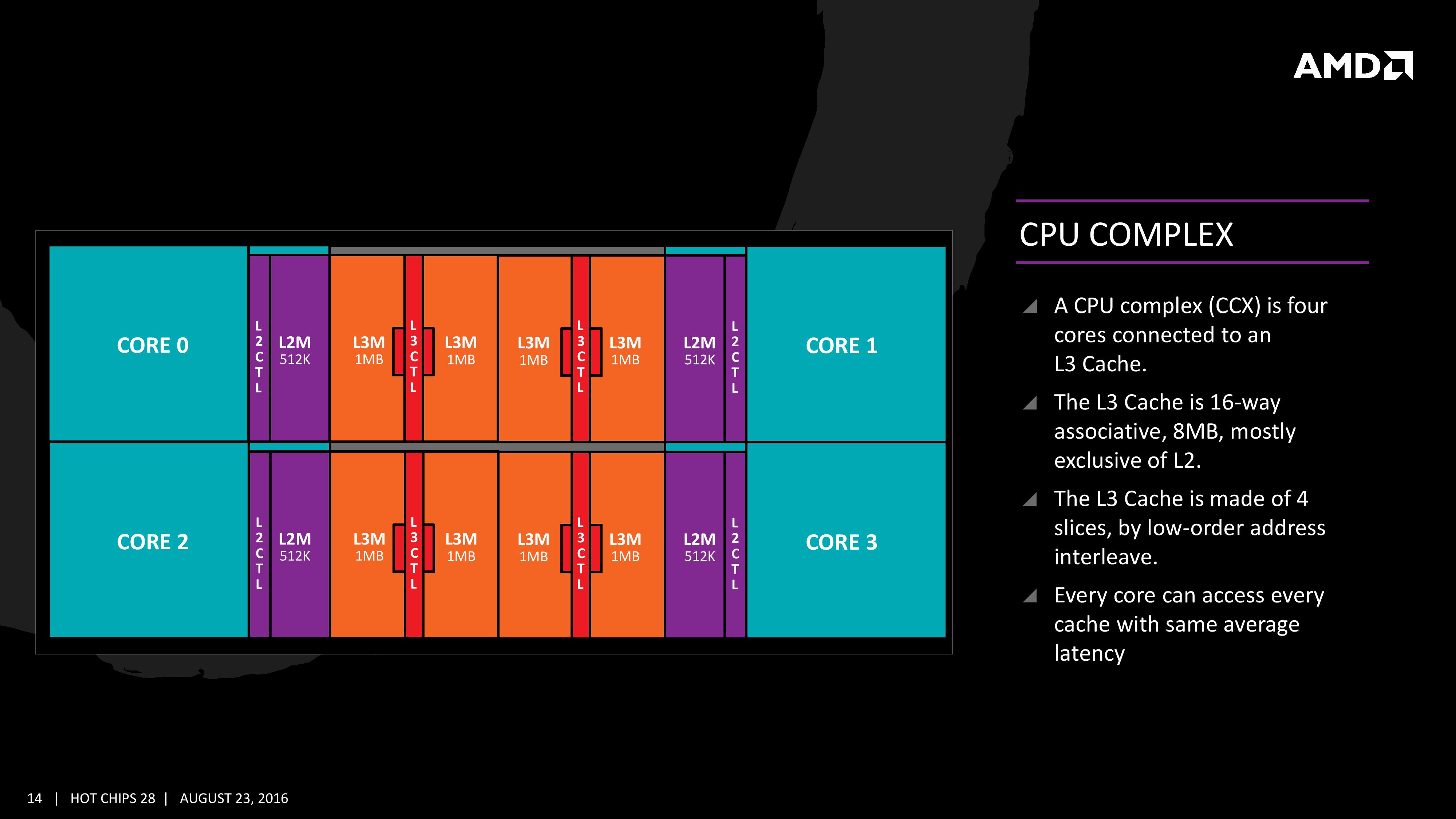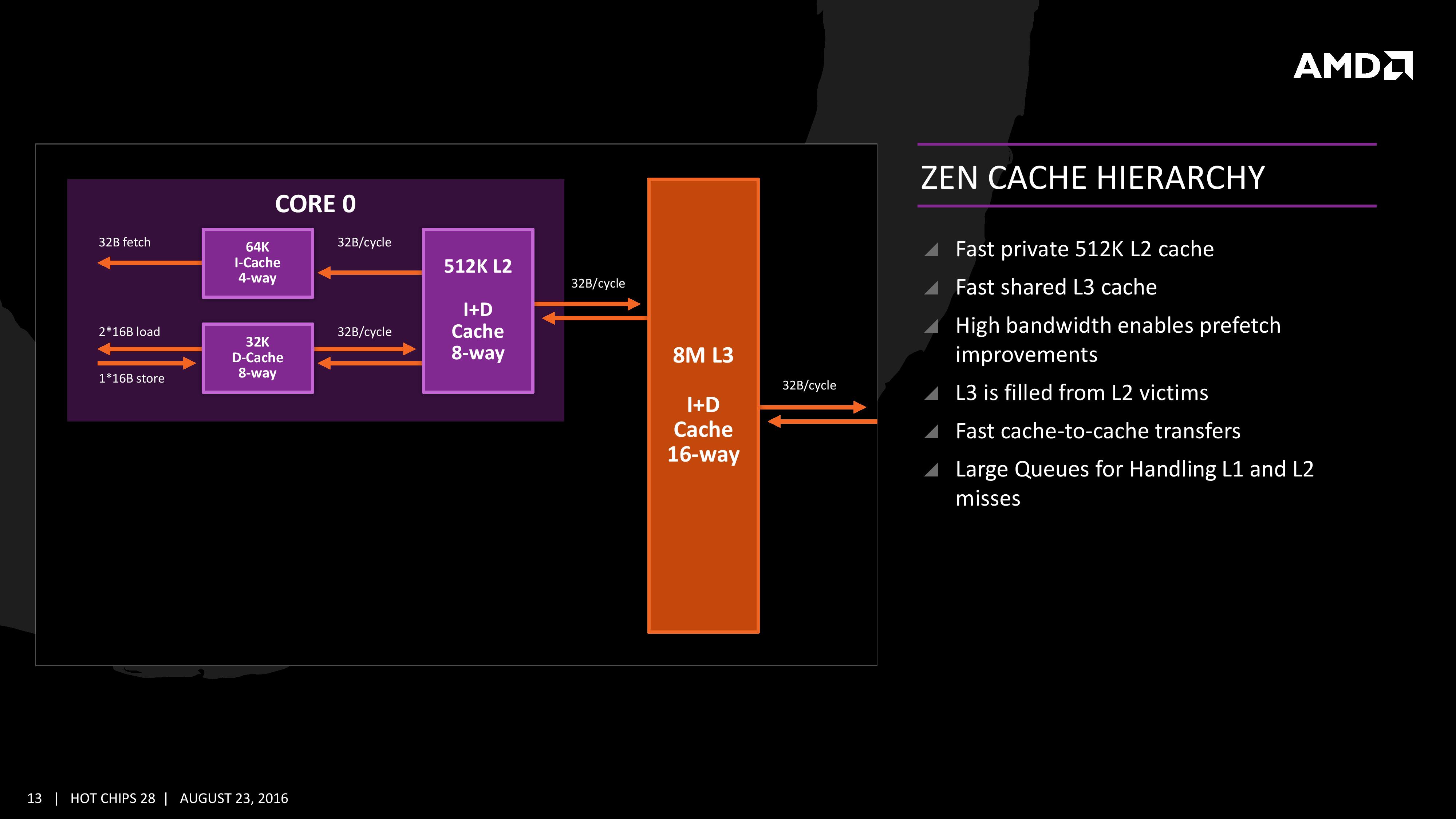AMD Zen Microarchiture Part 2: Extracting Instruction-Level Parallelism
by Ian Cutress on August 23, 2016 8:45 PM EST- Posted in
- CPUs
- AMD
- x86
- Zen
- Microarchitecture
The Core Complex, Caches, and Fabric
Many core designs often start with an initial low-core-count building block that is repeated across a coherent fabric to generate a large number of cores and the large die. In this case, AMD is using a CPU Complex (CCX) as that building block which consists of four cores and the associated caches.
Each core will have direct access to its private L2 cache, and the 8 MB of L3 cache is, despite being split into blocks per core, accessible by every core on the CCX with ‘an average latency’ also L3 hits nearer to the core will have a lower latency due to the low-order address interleave method of address generation.
The L3 cache is actually a victim cache, taking data from L1 and L2 evictions rather than collecting data from prefetch/demand instructions. Victim caches tend to be less effective than inclusive caches, however Zen counters this by having a sufficiency large L2 to compensate. The use of a victim cache means that it does not have to hold L2 data inside, effectively increasing its potential capacity with less data redundancy.
It is worth noting that a single CCX has 8 MB of cache, and as a result the 8-core Zen being displayed by AMD at the current events involves two CPU Complexes. This affords a total of 16 MB of L3 cache, albeit in two distinct parts. This means that the true LLC for the entire chip is actually DRAM, although AMD states that the two CCXes can communicate with each other through the custom fabric which connects both the complexes, the memory controller, the IO, the PCIe lanes etc.
One interesting story is going to be how AMD’s coherent fabric works. For those that follow mobile phone SoCs, we know fabrics and interconnects such as CCI-400 or the CCN family are optimized to take advantage of core clusters along with the rest of the chip. A number of people have speculated that the fabric used in AMD’s new design is based on HyperTransport, however AMD has confirmed that they are not using HyperTransport here for Zen. More information on the fabric may come out as we nearer the launch, although this remains one of the more mysterious elements to the design at this stage.
The cache representation in the new presentation at Hot Chips is almost identical to that in midweek, showing L1 and L2 in the core with 8MB of L3 split over several cores. AMD states that the L1 and L2 bandwidth is nearly double that of Excavator, with L3 now up to 5x for bandwidth, and that this bandwidth will help drive the improvements made on the prefetch side. AMD also states that there are large queues in play for L1/L2 cache misses.












106 Comments
View All Comments
Bulat Ziganshin - Wednesday, August 24, 2016 - link
I think it's obvious from number of ALUs that 40% improvement is for scalar single-thread code that greartly bemnefits from access to all 4 integer ALUs. Of course, it will get the same benefit fro any code running up to 8 threads (for 8-core Zen). But anyway it should be slower than KabyLake since Intel spent much more time optimizng their CPUsFor m/t execution, improvements will be much smaller, 10-20%, i think. Plus, 8-core CPU will probably run at smaller frequency than 4-core Buldozers or 4-core KabyLake. AFAIK, even Intel 8c-ore CPUs run at 3.2 GHz only, and it's after many years of power optimization. We also know that *selected* Zen cpus run at 3.2 GHz in benchamrks. So, i expect either < 3 GHz frequency, or 200 Wt power budget
atomsymbol - Wednesday, August 24, 2016 - link
"For m/t execution, improvements will be much smaller, 10-20%, i think."There are bottlenecks in Bulldozer-family when a module is running two threads. An improvement of 40% for m/t Zen execution in respect to Bulldozer m/t execution is possible. It is a question of what the baseline of measurement is.
Bulat Ziganshin - Wednesday, August 24, 2016 - link
M/t execution in Bulldozer already can use all 4 INT alus, so i think that 40% IPC improvement is impossible. In other words, if s/t IPC improved by 40% by moving from 2 alu to 4 alu arrangement, m/t performance that keeps the same 4 alu arrangement, hardly can be improved by more than 20%looncraz - Wednesday, August 24, 2016 - link
IPC is NOT MT, it is ST only.IPC is per-core, per-thread, per-clock, instruction retire rate... which generally equates to performance per clock per core per thread.
Bulat Ziganshin - Thursday, August 25, 2016 - link
you can measure instruction per cycles for a thread, 3 threads, core, cpu or anything else. what's a problem??My point is that s/t speed on Zen is improved much more than m/t speed, compared to last in Bulldozer family. So, they advertized improvement in s/t speed, that is 40%. And m/t improvement is much less since it still the same 4 alus (although many other parts become wider).
atomsymbol - Thursday, August 25, 2016 - link
AMD presentation was comparing Zen to Broadwell in a m/t workload with all CPU cores utilized.From
http://www.cpu-world.com/Compare/528/AMD_A10-Serie...
you can compute that the Blender-specific speedup of Zen over a previous AMD design is about 100/38.8=2.57
Bulat Ziganshin - Thursday, August 25, 2016 - link
Can you compute IPC improvement, that we are discussing here?looncraz - Thursday, August 25, 2016 - link
Except you're absolutely wrong, the performance increases will be much higher for MT than ST.Bulldozer was hindered by the module design, so you had poor MT scaling - not an issue with Zen. On top of that, Zen has SMT, which should add another 20% or so more MT performance for the same number of cores.
A 40% ST improvement for Zen could easily mean a 100% performance improvement for MT.
Bulat Ziganshin - Saturday, August 27, 2016 - link
It's not "on top of that". Zen is pretty simple Bulldozer modification that fianlly allowed to use all 4 scalar ALUs in the module for the single thread. It's why scalar s/t perfroamnce should be 40% faster. OTOH, two threads in the module still share those 4 scalar ALUs as before, so m/t perfromance cannot improve much. On top of that, module was renamed to core. So, there are 2x more cores now and of course m/t performance of entire CPU will be 2x higherNenad - Thursday, September 8, 2016 - link
It is possible that AMD already count SMT (hyperthreading) into those 40%.Their slide which states "40% IPC Performance Uplift" also lists all things that AMD used to achieve those 40%...and first among those listed things is "Two threads per core". So if AMD already counted that into their 40% IPC uplift, then 'real' IPC improvement (for single thread) would be much lower.